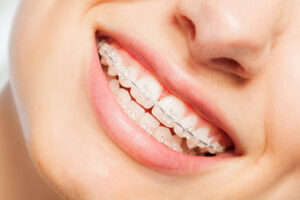 Misaligned or “crooked” teeth are a relatively common occurrence, and they can pose both functional and aesthetic concerns for patients. Sometimes, teeth come in crooked due to innate physical or hereditary causes. Other times, they become crooked later on as a result of other factors. Regardless of the cause, many symptoms of tooth and jaw misalignment remain the same, including difficulty with chewing, speaking, and maintaining optimal oral health. Some people also experience increased jaw and facial muscle strain due to involuntary bite overcorrection.
Misaligned or “crooked” teeth are a relatively common occurrence, and they can pose both functional and aesthetic concerns for patients. Sometimes, teeth come in crooked due to innate physical or hereditary causes. Other times, they become crooked later on as a result of other factors. Regardless of the cause, many symptoms of tooth and jaw misalignment remain the same, including difficulty with chewing, speaking, and maintaining optimal oral health. Some people also experience increased jaw and facial muscle strain due to involuntary bite overcorrection.
When it comes to hereditary factors, some people’s mouths are simply too small to accommodate all of their teeth as they emerge. In these cases, the teeth often become crooked or twist into abnormal formations as a result of overcrowding. In other cases, jaw misalignment can lead to irregular bite configurations. If the upper and lower jaw are out of alignment, or if one is a different size than the other, bite irregularities—such as an overbite or underbite—can result.
In addition to hereditary causes, tooth misalignment can also result from oral health concerns that develop later in life, such as tooth loss, gum disease, poor nutrition, inadequate dental care, and excess pressure on the jaw or teeth. Poorly-fitted dental restorations and traumatic injuries can also increase the likelihood of tooth and jaw misalignment in adults. Furthermore, the health of your baby teeth can influence the health of your permanent teeth, so it is important to encourage good oral health and hygiene habits in children. This means dedicated brushing and flossing, as well as the cessation of bad habits, such as thumb sucking or the use of pacifiers, past the recommended age.
Regardless of your age or the cause(s) behind your tooth misalignment, there are a variety of orthodontic treatment options that may be able to help give you straighter, more uniformly positioned teeth. Some of the most popular options include:
- Traditional metal braces are often regarded as the most durable and kid-friendly treatment option due to their sturdy design. They are also typically capable of treating even the most severe cases of misalignment, unlike more discreet options. For those concerned about the aesthetics of metal brackets and wires, our practice also offers clear or tooth-colored ceramic brackets, which are nearly invisible once placed.
- Invisalign® is one of the most popular orthodontic treatments available due to its transparent and convenient design. Unlike traditional braces, which are made of metal and bracketed directly to the teeth, Invisalign® clear aligners are inconspicuous and fully removable.
To learn more about our orthodontic treatment offerings, or to schedule a consultation with Dr. Banasiak, please contact our practice today!




 Basking Ridge
Basking Ridge
